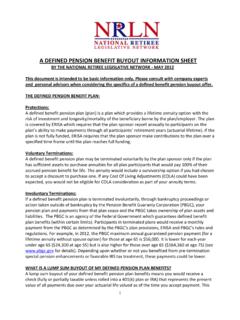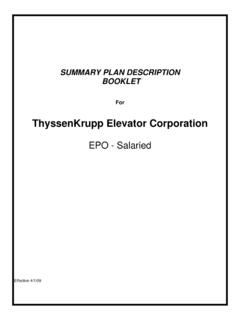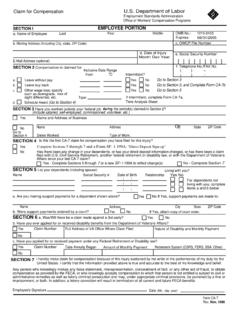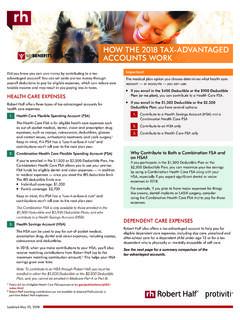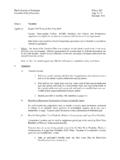Transcription of Protecting Retiree Benefits in Bankruptcy
1 1 Protecting Retiree Benefits in Bankruptcy 9/1/2017 Executive Summary Tens of millions of American retirees on fixed incomes rely on earned Benefits from their former employers for retirement income, critical medical treatment, and essential Benefits for their survivors. During their decades of work, retirees were promised these Benefits as part of their total compensation package. Workers and retirees have typically planned their retirement security on the continuation of these Benefits .
2 Unfortunately, a growing number of retirees and older workers are finding that these Benefits are the first things lost when their former employer files for Bankruptcy . Even though pension, health care, disability and life insurance Benefits are critical for basic health and well-being, Bankruptcy courts too often treat them as expendable. Since Bankruptcy courts view their priority under Chapter 11 as facilitating the company s survival and emergence from Bankruptcy , judges are inclined to agree to management s request to terminate or reduce the legacy costs of promised pension, health and welfare Benefits .
3 Unlike certain other creditors, retirees are not seen as necessary for the business going forward. And unlike suppliers, lenders, investors and even active employees who can diversify their risk or recoup a portion of their losses out of future dealings with the restructured company retirees typically suffer a permanent loss of those Benefits . Living on a fixed income and long-promised Retiree Benefits , they have no alternative to relying on their three- or four-decade investment in their employers fortunes.
4 In addition to the health, disability and survivor Benefits that can be canceled outright, there is also a growing gap in the legal protections for Retiree pension Benefits when plans are terminated in Bankruptcy . When an under-funded plan terminates, many retirees and other plan participants suffer a permanent loss of income despite the partial guarantees provided by the Pension Benefit Guaranty Corporation (PBGC). Workers and retirees learn only after plan termination that a number of PBGC policies can leave them with Benefits that are permanently reduced by 30% or more.
5 The most recent example is Avaya, which filed for Bankruptcy protection in January 2017. The company's original reorganization plan proposed to maintain both its pension plans after emergence from Bankruptcy . But the secured creditors ultimately convinced the court that the plan for salaried employees, which was only 58% funded, needed to be terminated and taken over by the PBGC. As a result, according to the PBGC, a substantial portion of the plan s participants will lose vested Benefits not guaranteed by the agency.
6 In reaction to this vulnerability, Congress has already legislated special procedural and substantive protections for Retiree Benefits in Bankruptcy . By adding Bankruptcy Code Section 1114, Congress recognized the need to protect critical health and welfare Benefits in a Bankruptcy process that would otherwise result in retirees bearing an unfair share of the cuts and losing everything before others give up anything. Unfortunately, large Bankruptcy cases in recent years have highlighted (or even AREF American Retirees Education Foundation 2 created) tragic shortcomings or loopholes in those protections, demonstrating the urgent need for legislative reform.
7 Because of current gaps in (and misinterpretations of) existing statutes, retirees often receive little or limited protection of their Benefits . Additional reforms are needed to level the playing field and protect the reliance of millions of retirees on vested Benefits earned over a lifetime of work. In this white paper (and a companion fact sheet) the National Retiree Legislative Network (NRLN) recommends a number of specific legislative amendments that can restore Congressional intent and further extend protections for retirees.
8 The statute should be amended to require prompt appointment of a Section 1114 committee to represent retirees in large Bankruptcy cases within 60 days after the Bankruptcy petition is filed and to ensure that at least the largest of the established Retiree organizations representing a substantial number of the non-union-represented retirees is appointed to the Committee. Congress should further revise Section 1114 of the Bankruptcy Code to clarify that the protections of Retiree health and welfare Benefits do indeed extend to any plan, fund, or program providing those Benefits (as Congress intended, but some courts have ignored), not only those Benefits a debtor failed to reserve the right to modify outside Bankruptcy .
9 In addition, Congress should amend Section 1114 to give Bankruptcy court judges the discretion to expand the power of a Retiree committee to negotiate over claims for termination of non-qualified pension Benefits in appropriate cases. Congress should provide that if a plan sponsor in Bankruptcy is permitted to terminate its qualified pension plan, then the Department of Labor or the PBGC can make a priority claim on behalf of plan participants and beneficiaries to recover the vested but unfunded Benefits that will not be guaranteed by the PBGC (after distribution of assets in the plan as of the termination date).
10 This would add a category to the list of unsecured claims that receive priority payment pursuant to Bankruptcy Code Section 507(a)(4). Congress should generally require the continued minimum funding of defined benefit pension plans during a Bankruptcy and explicitly provide that if those minimum contributions are not made, that claims by the pension trust or by the government on its behalf shall receive priority as an administrative expense under Bankruptcy Code Section 503(b).
